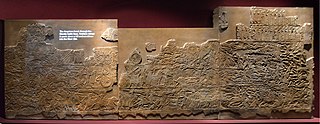Related Research Articles

Babylonia was an ancient Akkadian-speaking state and cultural area based in the city of Babylon in central-southern Mesopotamia. It emerged as an Amorite-ruled state c. 1894 BC. During the reign of Hammurabi and afterwards, Babylonia was called "the country of Akkad", a deliberate archaism in reference to the previous glory of the Akkadian Empire. It was often involved in rivalry with the older state of Assyria to the north and Elam to the east in Ancient Iran. Babylonia briefly became the major power in the region after Hammurabi created a short-lived empire, succeeding the earlier Akkadian Empire, Third Dynasty of Ur, and Old Assyrian Empire. The Babylonian Empire rapidly fell apart after the death of Hammurabi and reverted to a small kingdom.

Esarhaddon, also spelled Essarhaddon, Assarhaddon and Ashurhaddon was the king of the Neo-Assyrian Empire from the death of his father Sennacherib in 681 BC to his own death in 669. The third king of the Sargonid dynasty, Esarhaddon is most famous for his conquest of Egypt in 671 BC, which made his empire the largest the world had ever seen, and for his reconstruction of Babylon, which had been destroyed by his father.

Nabopolassar was the founder and first king of the Neo-Babylonian Empire, ruling from his coronation as king of Babylon in 626 BC to his death in 605 BC. Though initially only aimed at restoring and securing the independence of Babylonia, Nabopolassar's uprising against the Neo-Assyrian Empire, which had ruled Babylonia for more than a century, eventually led to the complete destruction of the Assyrian Empire and the rise of the Neo-Babylonian Empire in its place.

Ashurbanipal was the king of the Neo-Assyrian Empire from 669 BCE to his death in 631. He is generally remembered as the last great king of Assyria. Inheriting the throne as the favored heir of his father Esarhaddon, Ashurbanipal's 38-year reign was among the longest of any Assyrian king. Though sometimes regarded as the apogee of ancient Assyria, his reign also marked the last time Assyrian armies waged war throughout the ancient Near East and the beginning of the end of Assyrian dominion over the region.

Sîn-šar-iškun was the penultimate king of Assyria, reigning from the death of his brother and predecessor Aššur-etil-ilāni in 627 BC to his own death at the Fall of Nineveh in 612 BC.

Šamaš-šuma-ukin, was king of Babylon as a vassal of the Neo-Assyrian Empire from 668 BC to his death in 648. Born into the Assyrian royal family, Šamaš-šuma-ukin was the son of the Neo-Assyrian king Esarhaddon and the elder brother of Esarhaddon's successor Ashurbanipal.
Kandalanu was a vassal king of Babylon under the Neo-Assyrian kings Ashurbanipal and Ashur-etil-ilani, ruling from his appointment by Ashurbanipal in 647 BC to his own death in 627 BC.

The Battle of the Ulai River, also known as the Battle of Til-Tuba or the Battle of Tulliz, in c. 653 BCE, was a battle between the invading Assyrians, under their king Ashurbanipal, and the kingdom of Elam, which was a Babylonian ally. The result was a decisive Assyrian victory. Teumman, the king of Elam, and his son Tammaritu were killed in the battle.

The Neo-Assyrian Empire was the fourth and penultimate stage of ancient Assyrian history and the final and greatest phase of Assyria as an independent state. Beginning with the accession of Adad-nirari II in 911 BC, the Neo-Assyrian Empire grew to dominate the ancient Near East throughout much of the 8th and 7th centuries BC, becoming the largest empire in history up to that point. Because of its geopolitical dominance and ideology based in world domination, the Neo-Assyrian Empire is by many researchers regarded to have been the first world empire in history. And through this, the Assyrian Empire influenced culturally, governmentally, and militarily on the empires of the ancient world, including the Babylonians, the Achaemenids, and the Seleucids. At its height, the empire was the strongest military power in the world and ruled over all of Mesopotamia, the Levant and Egypt, as well as portions of Anatolia, Arabia and modern-day Iran and Armenia.

The timeline of ancient Assyria can be broken down into three main eras: the Old Assyrian period, Middle Assyrian Empire, and Neo-Assyrian Empire. Modern scholars typically also recognize an Early period preceding the Old Assyrian period and a post-imperial period succeeding the Neo-Assyrian period.

The Sargonid dynasty was the final ruling dynasty of Assyria, ruling as kings of Assyria during the Neo-Assyrian Empire for just over a century from the ascent of Sargon II in 722 BC to the fall of Assyria in 609 BC. Although Assyria would ultimately fall during their rule, the Sargonid dynasty ruled the country during the apex of its power and Sargon II's three immediate successors Sennacherib, Esarhaddon and Ashurbanipal are generally regarded as three of the greatest Assyrian monarchs. Though the dynasty encompasses seven Assyrian kings, two vassal kings in Babylonia and numerous princes and princesses, the term Sargonids is sometimes used solely for Sennacherib, Esarhaddon and Ashurbanipal.
The Gambulu, Gambulai, or Gambuli were a tribe of Arameans in ancient Babylonia. They were the most powerful tribe along the eastern border of Babylonia, or in the south toward the border with Elam. It is difficult to pinpoint their exact location. H. W. F. Saggs places them "south of the Diyala river toward the Elamite border."

Teumman was a king of the ancient kingdom of Elam, ruling it from 664 to 653 BCE, contemporary with the Assyrian king Ashurbanipal. In various sources, the name may be found spelled as Te’umman, Teumann, or Te-Umman. For a time, "many scholars, beginning with G.G. Cameron," believed him to have been the Tepti-Huban-Inshushinak mentioned in inscriptions, although this view has since fallen from favor.

Ummanigash was briefly a ruler in the ancient kingdom of Elam, ruling after the beheading of his predecessor Teumman in 653. He ruled part of Elam while his brother, Tammaritu, ruled another. He is also referred to as Humban-nikash II and Khumban-nikash II.
Tammaritu II was the ruler of Elam from 652 until 650 or 649 BC. After the brief reigns of Indabibi and Humban-haltash III, Tammaritu II was briefly restored to power in 648. Tammaritu II was the son of Tammaritu I and the successor of Ummanigash, his uncle.

Šērūʾa-ēṭirat, called Saritrah in later Aramaic texts, was an ancient Assyrian princess of the Sargonid dynasty, the eldest daughter of Esarhaddon and the older sister of his son and successor Ashurbanipal. She is the only one of Esarhaddon's daughters to be known by name and inscriptions listing the royal children suggest that she outranked several of her brothers, such as her younger brother Aššur-mukin-paleʾa, but ranked below the crown princes Ashurbanipal and Shamash-shum-ukin. Her importance could be explained by her possibly being the oldest of all Esarhaddon's children.

The Rassam cylinder is a cuneiform cylinder, forming a prism with ten faces, written by Neo-Assyrian king Ashurbanipal in the 7th century BCE, in 643 BCE. The cylinder was discovered in the North Palace of Nineveh by Hormuzd Rassam in 1854, hence its name. It is located in the British Museum.

The Assyrian conquest of Egypt covered a relatively short period of the Neo-Assyrian Empire from 673 to 663 BCE. The conquest of Egypt not only placed a land of great cultural prestige under Assyrian rule but also brought the Neo-Assyrian Empire to its greatest extent.

Tammaritu I, son of Urtak, was briefly a ruler in the ancient kingdom of Elam, ruling after the beheading of his predecessor Teumman in 653. He ruled part of Elam while his brother, Ummanigash, ruled another.

Tammaritu was a prince of Elam and son of Teumman, king of the ancient kingdom of Elam, who ruled from 664 to 653 BCE, and was a contemporary with the Assyrian king Ashurbanipal. In various sources, the name may be found spelled as Te’umman, Teumann, or Te-Umman. For a time, "many scholars, beginning with G.G. Cameron," believed him to have been the Tepti-Huban-Inshushinak mentioned in inscriptions, although this view has since fallen from favor.
References
- ↑ John Boederman (1997). The Cambridge Ancient History. Cambridge University Press. p. 147. ISBN 978-0-521-22717-9.
- ↑ D. T. Potts (12 November 2015). The Archaeology of Elam: Formation and Transformation of an Ancient Iranian State. Cambridge University Press. p. 269. ISBN 978-1-107-09469-7.
- 1 2 3 Sir Percy Sykes (15 April 2013). A History Of Persia. Routledge. p. 154. ISBN 978-1-135-64895-4.
- ↑ John Boederman (1997). The Cambridge Ancient History. Cambridge University Press. p. 52. ISBN 978-0-521-22717-9.
- ↑ Claude Hermann Walter Johns (1904). Babylonian and Assyrian Laws, Contracts and Letters. C. Scribner's sons. p. 360.
- ↑ Journal of the American Oriental Society. American Oriental Society. 1897. p. 145.
- ↑ Claude Hermann Walter Johns (1904). Babylonian and Assyrian Laws, Contracts and Letters. C. Scribner's sons. p. 360-1.
- 1 2 Claude Hermann Walter Johns (1904). Babylonian and Assyrian Laws, Contracts and Letters. C. Scribner's sons. p. 361.
- ↑ Elizabeth Carter; Matthew W. Stolper (1984). Elam: Surveys of Political History and Archaeology . University of California Press. p. 50. ISBN 978-0-520-09950-0.












